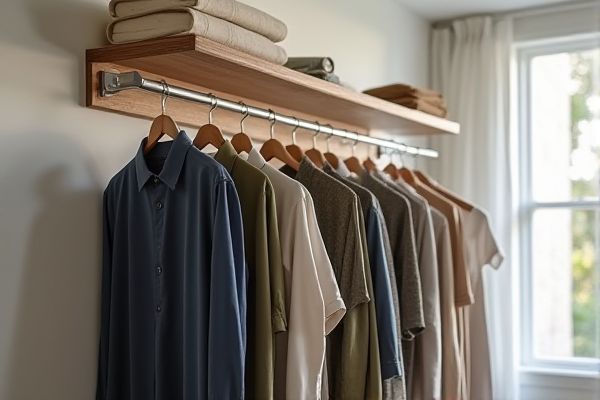
A clothes rod provides a fixed, sturdy space for hanging multiple garments, ideal for organizing your wardrobe or closet efficiently. Discover how a valet rod offers versatile, extendable convenience for preparing outfits and managing your daily clothing needs by reading the rest of this article.
Table of Comparison
| Feature | Clothes Rod | Valet Rod |
|---|---|---|
| Purpose | Hangs multiple clothes like shirts, jackets, pants | Temporary hanging for outfit planning or garment preparation |
| Installation | Usually fixed inside closets or wardrobes | Retractable and mounted on closets, dressers, or walls |
| Size | Long and sturdy to hold many items | Shorter and designed for quick use |
| Material | Metal, wood, or sturdy plastic | Metal or chrome-plated for smooth retraction |
| Functionality | Permanent clothes storage and organization | Convenient for hanging individual garments temporarily |
| Best For | Closets needing regular garment storage | Quick access dressing or outfit selection |
Understanding Clothes Rods and Valet Rods
Clothes rods are fixed or adjustable horizontal bars installed in closets to hang multiple garments, maximizing storage space and organization. Valet rods are retractable or pull-out bars used temporarily to hold outfits for coordination or outfit planning, often installed near wardrobes or closets for convenience. Unlike clothes rods, valet rods prioritize quick access and outfit management rather than long-term garment storage.
Key Features of Clothes Rods
Clothes rods are typically long, cylindrical bars installed in closets or wardrobes for hanging multiple garments such as shirts, jackets, and dresses, maximizing vertical storage space. They are made from durable materials like metal or wood and designed to support significant weight, often measured by load capacity ranging from 50 to 200 pounds. Unlike valet rods, clothes rods provide continuous hanging space for numerous hangers, optimizing organization and accessibility in everyday clothing storage.
Core Functions of Valet Rods
Valet rods are designed to provide a convenient, extendable hanging space for clothing such as suits, jackets, or outfits planned for the day, allowing your garments to stay wrinkle-free and easily accessible. Unlike fixed clothes rods, valet rods often retract or fold away when not in use, maximizing closet space efficiency. Their core function enhances wardrobe organization by offering a temporary, dedicated spot for your clothes, streamlining your daily dressing routine.
Materials and Construction Differences
Clothes rods are typically made from sturdy metals like stainless steel or aluminum, designed for heavy-duty use and supporting multiple garments. Valet rods often feature lighter materials such as brass or coated steel, prioritizing compactness and ease of use for hanging individual outfits. Your choice depends on whether you need durable, long-lasting support or a sleek, space-saving option for temporary garment hanging.
Installation Requirements Compared
Clothes rods require sturdy wall studs or ceiling mounts to support heavy loads, making installation more involved and often permanent. Valet rods typically mount inside wardrobes or closets using simple brackets, requiring minimal tools and less structural reinforcement. Your choice depends on available space and the ease of installation you need.
Space Efficiency: Clothes Rod vs Valet Rod
A clothes rod maximizes space by providing a long, horizontal bar to hang multiple garments, ideal for storing bulkier items and optimizing closet width. A valet rod, however, offers targeted space efficiency by extending from the closet wall or cabinetry, allowing you to hang a single outfit temporarily without occupying the main hanging area. Your choice between a clothes rod and a valet rod depends on whether you prioritize long-term storage capacity or convenient, space-saving outfit preparation.
Best Use Cases for Clothes Rods
Clothes rods offer optimal space for hanging multiple garments, making them ideal for organizing full wardrobes in closets, bedrooms, or dressing rooms. Their sturdy design supports various clothing types, from shirts and jackets to dresses, providing easy access and minimizing wrinkles. Best suited for long-term storage and daily outfit selection, clothes rods enhance closet efficiency by maximizing vertical hanging space.
Ideal Applications for Valet Rods
Valet rods are ideal for organizing outfits and preparing garments for the next day, making them perfect for bedrooms or dressing rooms. Unlike clothes rods, which are typically fixed and designed for long-term hanging, valet rods extend temporarily to hold suits, jackets, or accessories without causing wrinkles. You can conveniently install valet rods inside closets or wardrobes, offering a practical solution for short-term clothing storage and outfit planning.
Maintenance and Durability Considerations
Clothes rods, typically made from materials like stainless steel or wood, require periodic cleaning and occasional tightening to maintain stability and prevent rust or warping over time. Valet rods, often constructed from metal or high-quality plastic, offer durable, compact designs with fewer components, reducing maintenance needs but demanding careful handling to avoid bending or breakage. Both options benefit from routine inspection and proper installation to ensure long-term functionality and preserve material integrity.
Choosing Between Clothes Rod and Valet Rod: Factors to Consider
Choosing between a clothes rod and a valet rod depends on space availability, intended use, and convenience. Clothes rods provide continuous hanging space ideal for storing multiple garments, while valet rods offer temporary, easily accessible hooks for outfits or garments in transition. Consider the frequency of use, closet layout, and whether you need a permanent or adjustable solution when selecting the optimal rod.
 homyna.com
homyna.com